BCG — Boston Consulting Group
Walter Reinl, Anupam Sahay, and Tjun Tang
June 2021
Life insurers find themselves at the beginning of what promises to be a challenging decade.
Those that delay or attempt to cling to the status quo could face the same mixed fortunes as those fixed-line telecom operators whose business models were upended by technological and social change.
In turn, insurers that move boldly to adapt their strategies, operations, and organizations to new realities can still expect to grow and prosper in the years ahead.
A Challenging Environment
In the 2020s, life insurers face stiff competition from a broad range of new competitors seeking to capture market share. Asset managers, segment specialists, multi-line financial institutions, conglomerate owners, back-book consolidators, private equity sponsors, and insurtech players are all trying to carve out their own niches in the life insurance industry.
Boundaries are blurring. Insurers will feel pressure to pick their battleground and concentrate on specialties where they have sustainable advantage. Already, we see many life insurers honing positions as protection specialists, investment managers, or next-generation distribution powerhouses.
At the same time, the insurance industry is experiencing rapid adoption of both data analytics and digital technologies including AI. These technical changes have ripple effects on customer expectations, operating cost structures, and business models.
As these changes take place, data analytics and AI will no longer be considered particularly innovative. Instead, they will be an intrinsic component of the way business is done across the whole value chain.
Despite their risk-averse corporate cultures and complex legacy IT systems, life insurers will have no choice but to adapt to keep up.
China offers a glimpse into just how fast these changes can take place with early digital adopters like Ping An and new entrants such as Zhong An, Huize and Waterdrop initially leading the way, but traditional players now moving quickly to adapt.
Meanwhile, low-for-longer interest rates and unusually flat yield curves will complicate the economics of the insurance business by reducing new money yield, increasing the value of liabilities, and reducing the consumer appeal of endowment and annuity products versus alternatives such as deposits and fund products.
These challenges are especially severe for insurers in Japan, Europe, and the U.S. where interest rates may stay very low for the foreseeable future.
At the same time, active regulation around capital adequacy, consumer protection, and distributor conduct will most likely end up shrinking risk appetite, changing distribution dynamics, and hobbling certain traditional categories such as guaranteed return products.
Risk-based capital regimes like the upcoming Hong Kong Risk-Based Capital (RBC) framework are making traditional life insurance products economically less attractive to insurers.
Insurers would like to push investment-linked policies, but these products are not favored by sales agents due to lower commission rates and requirements in some markets to disclose commission earnings to customers.
SHAPING UP TO WIN IN THE ‘20s
To overcome the challenges they face and win in the ’20s, life insurers must address five related areas to better serve their customers and create value for shareholders (see Exhibit 1).
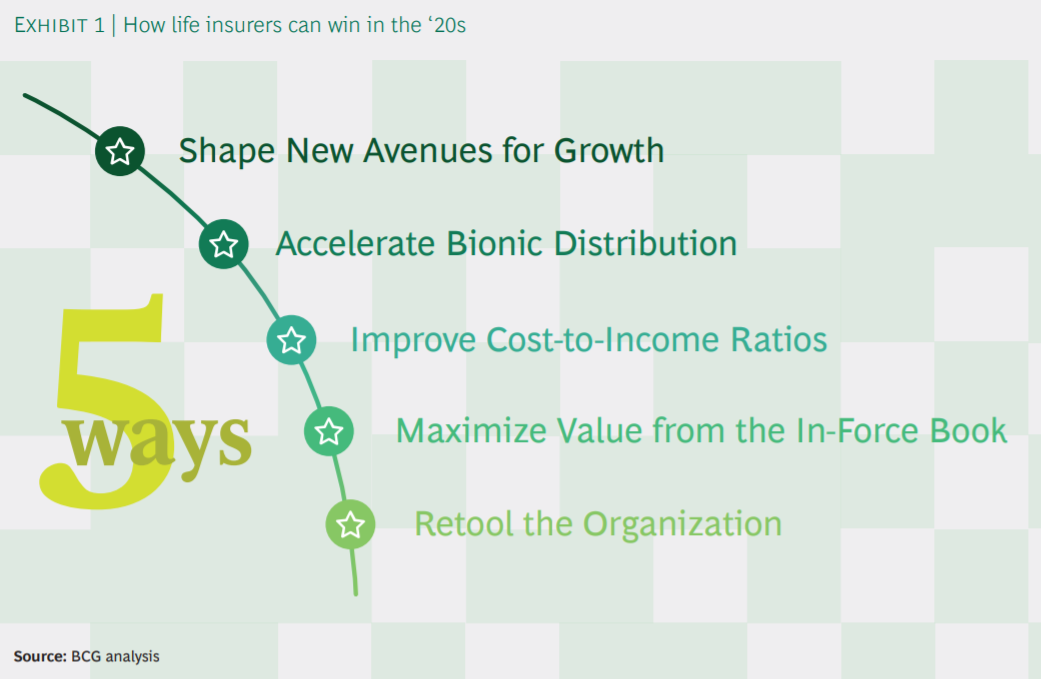
Shape New Avenues for Growth
While insurers face increasing competition and regulation in their historical growth centers, they also have new ways to grow. For example, rising demand for life insurance in underpenetrated emerging markets, especially in Asia, seems likely to benefit all insurers there over the next decade (see Exhibit 2). As these growth markets mature, domestic players will offer fierce competition, as they have already done in China and India. Still, multinational insurers have opportunities to enter or accelerate their business in these growth markets. Overextended companies should review their portfolios and prune unprofitable lines of business to refocus their attention on markets where they can win and profit.
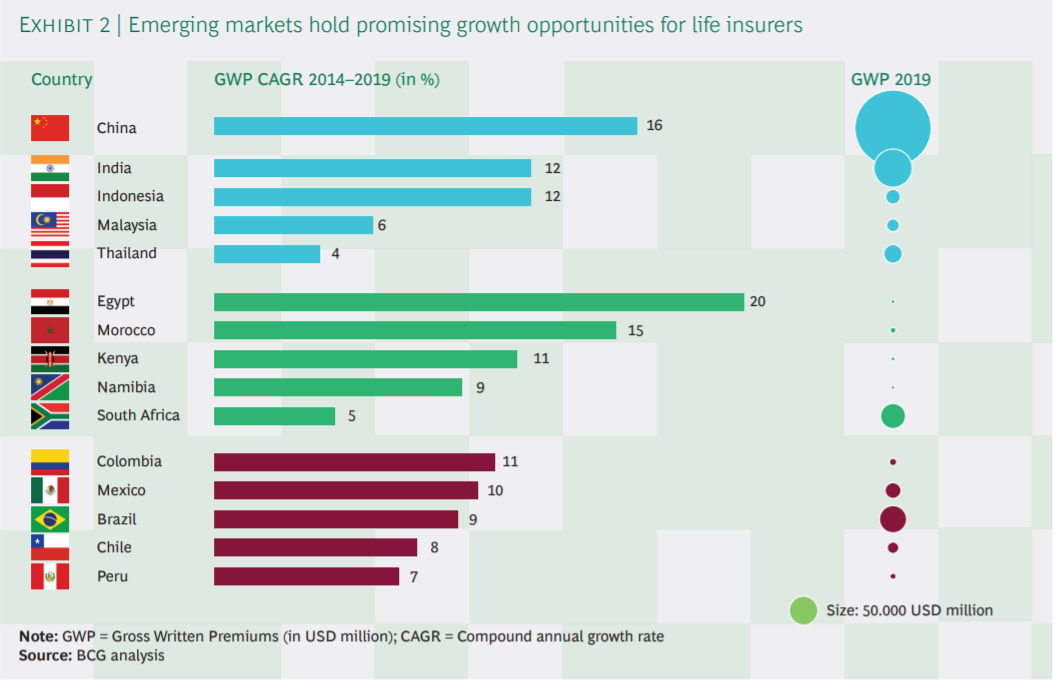
The life insurance sector will see further unbundling and modularization. The rise of simple digital offerings will accelerate this unbundling and product innovation. The ongoing divergence of Protection from Pensions & Savings will also continue. Insurers will develop partnerships with players from other industries while using value-added services to complement and enrich products. They will package these products into “services” or “life solutions” such as wellness offerings for healthier lives or investment services that enhance wealth. The most successful firms will be those that reevaluate their product strategies to innovate in ways that meet changing customer needs and desires across market segments.
Insurers will need to develop specialized technical skills and build their capabilities in asset management and wealth management to tap into some of the most promising growth opportunities. The retirement space, for instance, offers a ‘wall of money,’ especially in mature markets where demographics are driving a massive switch from accumulation to decumulation. Those mature markets are also seeing a shift from defined benefits to defined contribution retirement plans.
Health Insurance
Health insurance is another promising adjacent space for life insurers. The COVID-19 pandemic has made health generally and health insurance specifically a major concern for many consumers.
There are natural linkages between life insurance and health insurance, although health insurance tends to benefit from much higher customer engagement.
The economics of the health business can vary considerably between Individual and Group segments, as well as Indemnity versus Fixed-benefits products.
Health insurance is shifting from protection-based products toward value-added prevention and wellness services with the rise of telemedicine, testing, tracking, and chronic disease-advisory.
To succeed in this space, life insurers will need to establish partnerships, develop a clear strategic focus, define a unique customer proposition, and build their health insurance expertise.
Companies in many industries from e-commerce to telecommunications are eager to find new ways to monetize their customer base.
This gives insurers an opportunity to form partnerships and acquire new customers by joining ecosystems with large existing customer bases.
The challenge for insurers will be to improve the economics of acquisition and conversion by using sophisticated data analytics and to reimagine the customer experience.
ACCELERATE BIONIC DISTRIBUTION
Digital technology and data-driven AI will complement, augment, and sometimes replace human activity across many industries over the next decade. Life insurance is not immune to this development. The insurers who win in the 2020s will be those who shift toward a “bionic” operating model that combines advanced technological capabilities with a deft human touch (see Exhibit 3).
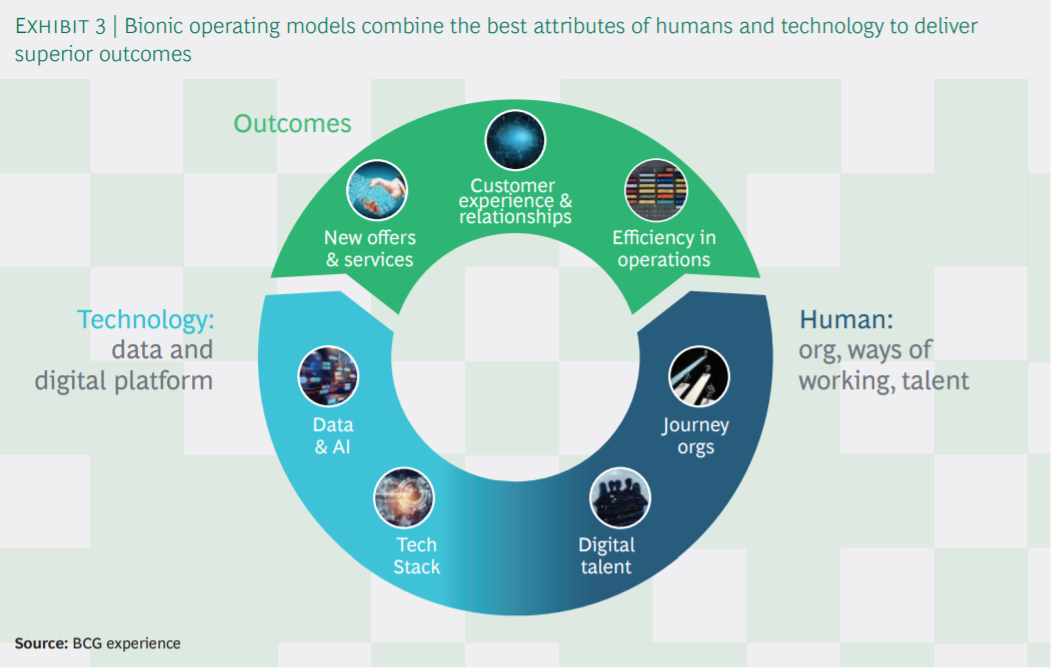
For starters, insurers will need to figure out how to deploy a salesforce of bionic agents and advisors equipped with next-generation mobile digital tools, multi-sourced lead-flow, and advanced customer analytics to enable straight-through or even pre-underwritten processing of customer applications.
Insurers also have an opportunity to transform the advice that agents provide to customers. Such advice currently depends on the individual capability and judgement of each agent, but AI could give agents analytically-driven prompts and nudges to make the most appealing offers at the right time that are tailored to the needs and preferences of each customer.
By combining the best human qualities of empathy and engagement with the rigor of AI, insurers can build a potent bionic salesforce. Of course, insurers will still need to recruit good sales agents and then train, incentivize, and manage them properly, but these activities too will benefit from technological support. In an era where regulators and customers are both scrutinizing sales practices, technology can enhance salesforce productivity and deliver a superior customer experience.
While banks have withdrawn from ownership of insurers since the global financial crisis, banks and quasi-bank financial institutions still are important distributors of third-party life insurance products, especially in Asia and Europe. As banks rapidly digitalize their operations and their customers increasingly “bank” through mobile devices, old models that depended on customers walking into a branch to buy life insurance from bank personnel or dedicated insurance specialists will become obsolete. Insurers and banks will both need to adapt to new technology-enabled Bancassurance 3.0 models that feature offers based on comprehensive customer profiles compiled from both bank and third-party data. Customers will access these offers through multiple types of journeys including online, mobile, offline, and hybrid/O2O (online-to-offline) journeys.
Meanwhile, customer and platform owners across the world, including e-commerce, technology, mobility, and telecoms players, will continue their efforts to monetize their large customer bases through ecosystems and partnerships with product and service providers such as insurers. The European “Open Banking” decree will accelerate this trend by requiring financial and non-financial players to share data.
As a result, we anticipate rapid growth in the formation of both bespoke and open-architecture partnerships between customer/platform owners and insurers. To scale these partnerships commercially, insurers will need to speed up their product cycles, build seamless digital and O2O customer experiences, forge API-driven technology linkages, develop more flexible and agile cultures, and find ways to align their economic interests with those of their new partners.
In the past, life insurers thought that high acquisition costs and product complexity made direct-to-consumer (D2C) sales impractical. In fact, experimentation by insurtechs and examples like that of Assurance IQ (acquired by Prudential Financial in 2019) are paving the way for D2C insurance sales. The rapid growth of online term life sales in India and mobile-driven demand for micro-insurance in emerging markets demonstrates the potential of the D2C channel. Not all D2C sales or communication will happen online. The most successful insurers will be those who figure out how to guide customers through a seamless set of O2O interactions across digital, telesales, and advisory channels.
Improving Cost-to-Income through Bionic Operations
From an operational perspective, the time is ripe for insurers to move beyond incremental improvements and embrace opportunities to drive down costs while also transforming the customer experience. To understand both the potential for improvement and the scale of the challenge, consider the banking sector. Over the past decade, many legacy banks have improved their cost-to-income ratios, but they still face intense competitive pressure from neobanks.
Here are six ways that insurers can improve their cost-to-income ratios:
1.Root out operating costs by taking the next step beyond centralized processing to fully automate end-to-end processes and leverage the potential of robotic process automation (RPA).
2. Reimagine customer journeys around human-centric design, while using technologies such as digital identity, eKYC (Electronic Know Your Customer), OCR, facial recognition, and e-payments to save customers time and reduce friction. Pre-underwriting and GIO (Guaranteed Issuance Option) can accelerate automation by reducing interruptions in the customer journey.
3. Modernize the technology stack with greater use of modular architecture, third party software, API connectors, and cloud-based platforms. By placing a data and digital platform on top of legacy systems and leveraging the cost benefits and scalability of the cloud, life insurers can improve their agility and speed-to-market (see Exhibit 4).
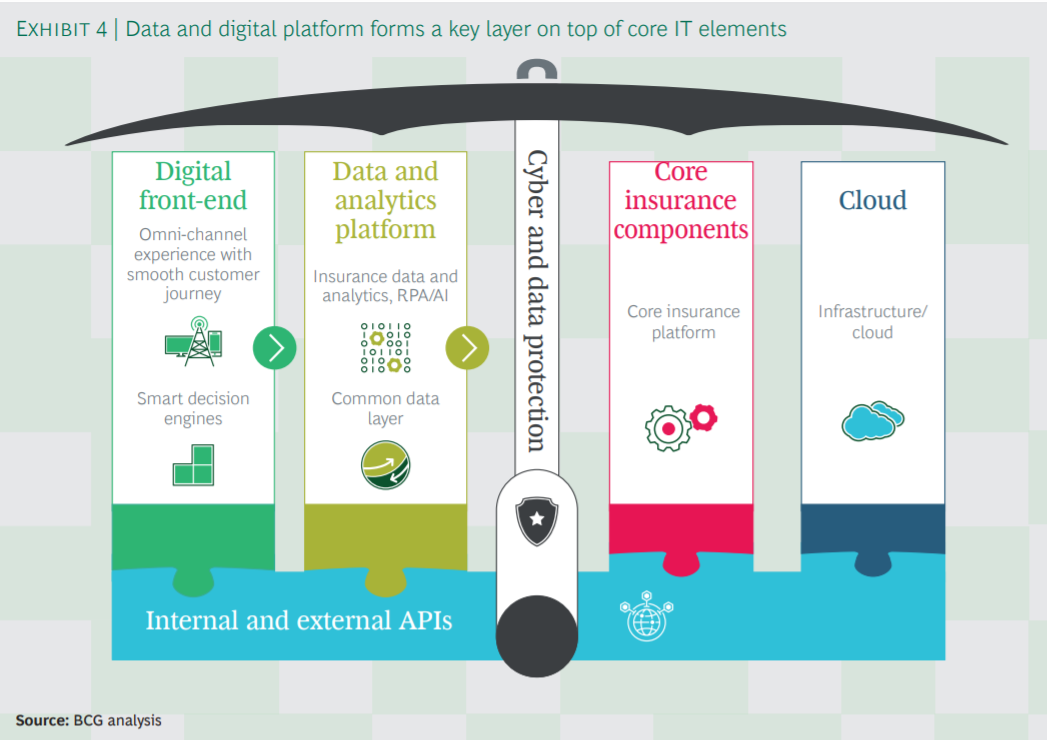
4. Unleash the power of data by revamping data governance, architecture, and storage, while building analytics and AI/machine learning capabilities. Insurers should identify, pilot, and then scale up those use-cases that create the greatest dollar value and the most practical benefits for business users.
5. Enrich underwriting by combining third-party data with in-house data and customer-consented information to make better model-driven decisions, including pre-underwriting that can simplify and speed up both the customer and distributor experience.
6. Streamline claims and seek to match the performance of P&C (General) insurers that offer rapid resolution/settlement, even for more complex claims.
By taking action in these six areas, life insurers can significantly improve their operational efficiency and effectiveness, enabling step-change improvements in cost curves.
Extract Value from the In-Force Book
The Smart Multiple® approach from the BCG ValueScience Center has shown that more than 80% of a company’s valuation variance can be explained by six factors, with ROTE (return on tangible equity) playing the most significant role (see Exhibit 5). Investors reward companies that can generate high returns on their existing capital. For life insurers, this means that uplifting returns on their in-force books can generate better total shareholder return.
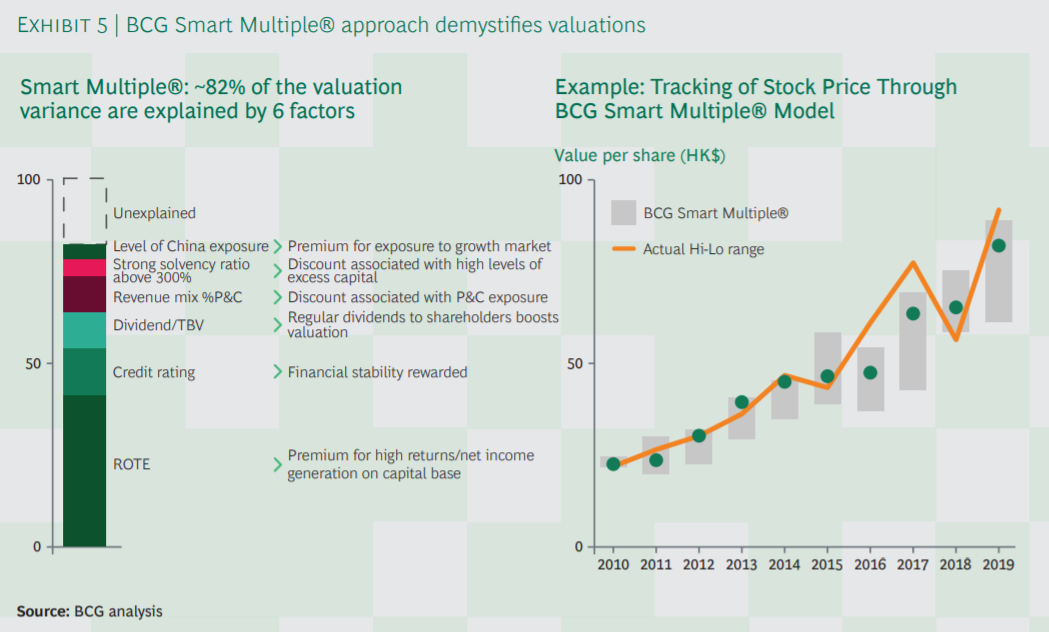
Most life insurers, especially those in mature markets, derive profits and dividends mostly from the in-force book, rather than the new business. Insurers can extract the maximum value from their in-force book by focusing on ways to reduce unit costs, enhance investment returns, and optimize capital in the back-book. They can use data-driven analytics to build robust programs around increasing upsell and cross-sell business with existing customers.
Ultimately, each insurer should review how it could enhance the value of the book and determine whether it is the best owner-operator of the policies or whether policyholders and shareholders could obtain a better outcome from a sale of the inforce policies to focused back-book consolidators.
RETOOLING THE ORGANIZATION
The decade ahead will be filled with change for the life insurance industry. To compete and win in this era, life insurance leaders will need to transform their organizations in four main ways:
- Add new talent and skills. The insurance workforce of the future will depend on modern technologists such as data scientists, AI and ML specialists, cloud architects, app builders, product developers, customer experience experts, and more (see Exhibit 6). To find, hire, and build this type of workforce, insurers will have to rethink the way they plan, recruit, train, and develop their people.
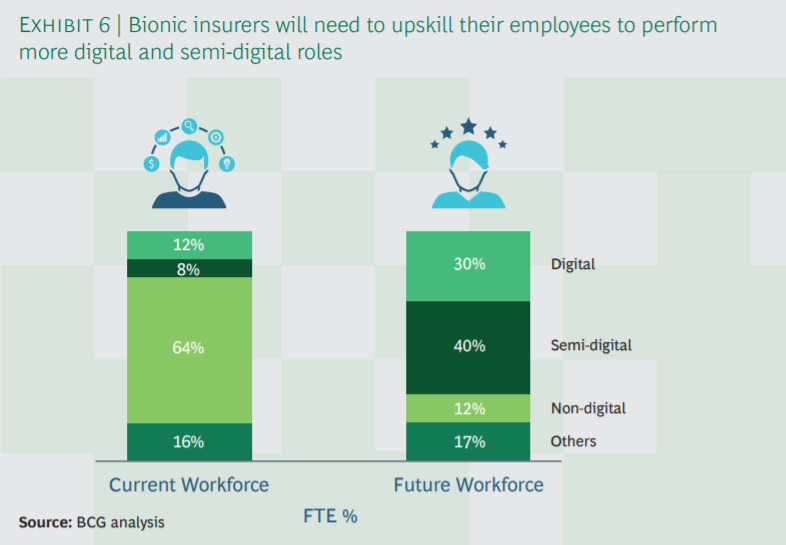
- Adopt agile ways of working. Today, insurers still often operate through departmental silos that slow down speed and reduce efficiency. This type of structure and organization depends on sequential handovers between marketers, product developers, actuaries, IT, finance, compliance, and distribution that undermine any attempts to accelerate product development. Like other industries, insurers can benefit from incorporating agile ways of working that are cross-functional, collaborative, iterative, and goal-driven. Agile is easy to describe, but difficult to master. The best approach is to launch agile pilot projects, learn from experience, and then scale the most effective practices across the organization.
- Commit to ESG principles. As substantial employers and large institutional investors, insurers should lead the way in ESG, with a clear purpose, diverse workforce, sustainable operations, and ethical investments. Insurers with strong ESG commitments may have an advantage when it comes to recruiting talent, engaging existing employees, and reducing both reputational and operational risks.
A TIME FOR BOLD LEADERSHIP
For the insurance industry, the 2020s will likely be a decade of rapid change, intensifying competition, and challenging macroeconomic conditions. Insurance leaders who avoid taking risks may well find themselves on a path of slow decline and fading relevance.
Such a fate is not set in stone. Life insurers can thrive and transform themselves in the ’20s if their leaders take decisive action to empower employees, strengthen organizational capabilities, and become more agile.
Leaders will have to take measured risks — whether by uplifting capabilities, transforming the business model, pursuing acquisitions in attractive adjacent sectors, forging new partnerships, or outsourcing pieces of the value chain. They will also need to plan for a wide range of business scenarios and consider all options to improve the economics and balance sheet of the in-force business.
The most successful insurers of the ’20s will be those that meet the massive shifts in their industry head-on. With a clear vision and a strong sense of purpose, bold insurance leaders can guide their organizations through the turbulent years ahead while continuing to deliver both business and social value.
For additional insights, please refer to these BCG publications:
- Advisors Still Matter to Life Insurance Customers
- Life Insurers May Find New Growth in Wellness
- Life — and Life Insurance — in a Time of Negative Rates
- A Growing Urgency for Change in the Life Insurance Industry
Find much more information in the Life Insurance section of BCG.com.
About the Authors
Walter Reinl is a managing director and partner at the Zurich office of Boston Consulting Group.
Anupam Sahay is a managing director and senior partner at the Singapore office of Boston Consulting Group.
Tjun Tang is a managing director and senior partner at the Hong Kong office of Boston Consulting Group.
Originally published at BCG
To download the PDF:
https://web-assets.bcg.com/18/01/7357ee7a4ab489490ce8079bae1e/bcg-the-future-of-life-insurance-five-ways-to-win-june-2021.pdf













